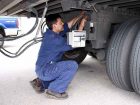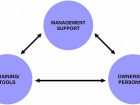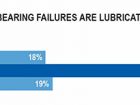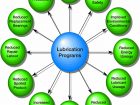
Products & Equipment
Heavy Equipment
Lubrication Asset Management
The Three Pillars of a Lubrication Asset Management Program
September 28, 2015 By Mike Deckert
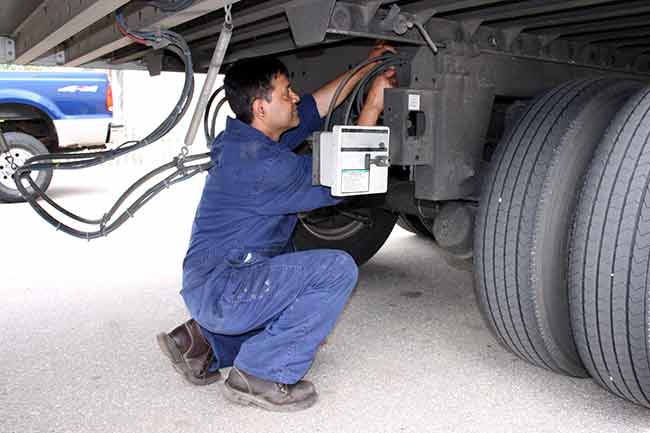 Developing an Asset Management Program means fundamentally changing from a reactive system to a proactive system for maintenance.
Developing an Asset Management Program means fundamentally changing from a reactive system to a proactive system for maintenance. In setting up a lubrication program, you first have to understand that any asset management program, to be viable and sustainable, must be based on three fundamental, equally important support pillars: management support; training & tools; and ownership/personnel. If any of the pillars fail, the whole program will fail.
Management support ensures the needed resources are allocated to the program. Training ensures that there is a sufficient amount of knowledge, understanding and buy-in amongst all the parties involved (front-line workers, senior management, etc.). Personnel ownership guarantees the program is carried out as planned.
It’s a simple enough concept – so why does lubrication require special consideration? Manual lubrication is still today, the predominant method of lubrication, with over 95 per cent of all bearings lubed manually. Consider that in typical operations, maintenance budgets are declining, with fewer people carrying out lubrication requirements and analysis; and that production requirements have increased meaning longer intervals between servicing for the equipment and less time for scheduled lubrication or maintenance.
Pillar 1 – Management Support
As one of the three support pillars, management must understand the importance of lubrication. What is the impact of lubrication on maintenance? How much does downtime cost, even just to lubricate one machine? What is the “payback” of proper lubrication training?
The goals of an asset management program are to maximize life cycle, minimize maintenance cycles and maximize efficiency. In a study conducted by a major component manufacturer, improper lubrication accounts for 53 per cent of all bearing failures, a major cause of machine downtime and significant maintenance costs. The majority of failures are caused by: contamination of bushings by dust, dirt and moisture; inadequate amounts of lubricant applied to bearings; or over-lubrication of key pivot points.
Ask yourself, what happens if there is a failure? What are the resulting costs or impact? Direct costs resulting from inadequate lubrication can include replacement bearings and parts; the labour to repair or replace the bearings and parts; the manpower (internal or external); equipment costs if special tools are required to make the repairs; rental costs for a replacement machine; lost time and the impact on meeting customer delivery commitments. Indirect, but very real costs can include work safety and housekeeping issues, wasted lube, environmental issues, and higher labour costs related to inefficient manual lubrication practices.
So if you’re a paving company, what’s the real cost of losing a bearing on your paver? Is it the cost of the new bearing? Is it the bearing, plus the labour to repair it? Or does the real cost also include the expense of all the equipment and crew standing idle because the paver is down, and the resulting penalties for missing lane openings or completion datelines?
Pillar 2 – Ownership / Personnel
It’s not enough for management to understand that lubrication is a critical component of asset management – they must promote and facilitate that understanding throughout the organization. Lubrication can no longer be the “ugly duckling” or the job no one wants to do. Fundamentally, an asset management program requires a shift in ongoing maintenance activity from repair and emergency breakdown activity to scheduled preventive and predictive activity. Breakdowns will always happen, but the obvious goal is to spend more time on the controlled and cost-friendly, preventative maintenance activity, and to minimize the more inefficient and costly, emergency breakdown activity.
Communication and buy-in will be key. We’re not talking about hands-on, “how-to” training here (that’s in the next section) – we’re talking about conveying to all employees a clear message about the “financial benefits” of a good lubrication program and management’s support of that program, through words, policies and appropriate funding. If management doesn’t support and fund the program, there is no proactive maintenance.
Furthermore, the personnel responsible for the lubrication program must have authority to make decisions. People must be allowed and trained to take ownership and there has to be a total understanding of the responsibilities of each participant. We have to move away from the practice of “the greaser is whoever is on ‘light duty/ injured’ this week.” We have to stop using the old adages: “We’ve always done it this way,” and “If it ain’t broke, don’t fix it.”
Finally, who needs to hear this enlightened message about lubrication? In a word… everyone. The systems and information in place are only useful if everyone understands them, believes in them and uses them properly. That means not just the oilers, mechanics and millwrights, but also the entire management/supervisor team, purchasing and everyone else.
Pillar 3 – Training & Tools
You hear it all the time – the world is changing faster today than it ever has before. Technology will advance more in the next five years than it has in the last 20 years. We have to harness new technologies in current and future projects. We have to “push the boundaries” to capitalize on these new technologies and discover new efficiencies. At the same time however, industry has lost a lot of expertise in the last five years as Boomers retire, and there is a reduction in skilled trades, making training a priority.
We have to retrain in the basics of lubrication (understanding equipment requirements; the functions and fundamentals of lubrication; selecting the right lubricant to do the job; understanding and setting meaningful specifications, etc.). Again, this means getting purchasing and managers/supervisors involved and knowledgeable, and facilitating ownership of tools and machines – if people know how, they will take ownership.
Where and how will the training take place? There are several sources of training available. Aside from traditional community colleges and night school, there are many companies offering paid courses, as well as industry groups and associations that put on training seminars, courses or “lunch and learns.” You can also bring outside expertise to you in the form of equipment and fluid suppliers (lubricant suppliers, automatic lubrication system suppliers, etc.).
What are the benefits of training? In the end, your enlightened, trained lubrication personnel become an effective and coordinated team and an integral part of the maintenance program, ensuring continued asset integrity.
Remember the funding mentioned earlier? In addition to know-how, your people will need some or all of the following tools:
Lubricant Fundamentals
What is a grease? A grease is a solid or semi-solid formed when a thickening agent is dispersed in the base oil. How do additives alter the performance of a grease? Special performance additives give grease their final special properties (oxidation inhibitors, rust and corrosion preventatives, EP/anti-wear additives, structure modifiers/thickeners, adhesive/water resistance properties, etc.). Are all #2 greases the same? No. Greases with the same NLGI Grade can have different, structural stability, dropping point, base oil viscosity, and more.
These are the lubricant fundamentals, the types of questions to which your people need to have answers, or at the very least, know to ask. Our own experience at training seminars we’ve conducted has shown us that many people come in lacking basic lubrication knowledge. In fact, in some cases, they didn’t even know the questions to ask or where to find the information.
Automatic Systems and Equipment
Many people are still using “gut feel” and “the more grease, the better” approach to lubricating, contributing to the 53 per cent of all bearing failures mentioned earlier. Whether you know it as an automatic lubrication system (ALS), an autogreaser or a centralized grease or oil lubrication system, an ALS automatically lubricates multiple points on a machine from a centralized pump/control unit, mounted in an easily accessible location. A system dispenses small measured amounts of lubricant at frequent intervals while your machine is operating, maintaining a uniform supply of grease in the bearing at all times and a consistent lubricant seal to prevent dirt and contaminants from migrating into bearings. This is compared to the feast and famine conditions often associated with manual lubrication.
The many benefits of an ALS include:
- Safety – no climbing over machinery or inaccessible areas (gases, fumes, confined spaces, etc.);
- Efficient lubrication, while machine running, no over/under lubrication;
- Apply in small, metered amounts, more frequently;
- Better housekeeping, less chance of spillage or leakage;
- Longer machine life, bearing areas consistently protected;
- Less downtime, reduces maintenance costs and bearing replacement; and
- Lower power cost, less friction.
ALS is not the “be-all and end-all” of lubrication, it is just a tool. Proper training, understanding and ownership of that tool is a must.
Oil Analysis Programs
An oil analysis program is a detailed, formalized procedure for sampling and testing fluids in a lab. Analysis is conducted on the lubricant’s properties (both the base oil and its additives), suspended contaminants, and wear debris from the machinery. Regular analysis provides meaningful and accurate trending data results on the lubricant and machine condition, which over the life of a particular machine can help improve equipment reliability, eliminate costly repairs and maintain production uptime. Oil analysis can, for example, provide early warning signs of impending machine failure; assess the remaining useful life of additives in the oil to determine when an oil must be replaced; or assist in isolating a root cause of a machine failure and ultimately a solution.
An oil analysis program outlines everything from what components on which machines will be sampled, how, when, where will a sample be collected; how data will be recorded; testing procedures; data review and trending; suggested solutions to problems; to ultimate cost benefit analysis based on established goals and objectives of the program.
Fluid Condition Monitoring Systems
A fluid condition monitoring system is a piece of equipment, mounted on a critical machine, which incorporates a suite of sensors (with communications interface) for assessing the condition of the machine lubricant through real-time, online measurements. This system can alert you to an array of fluid degradations, including soot or water contamination, additive depletion, the presence of metallic wear debris and particulates, or decrease in viscosity. In short, similar to an oil analysis program, diagnostics systems: enable condition-based fluid maintenance; identify equipment faults prior to failure; extend equipment and/or fluid service life; and provide in-depth fluid and system health insight, but for a single machine.
Set Goals
Last, but most important, what good is a tool if you don’t know what it’s for? Selection and implementation of the previously mentioned tools and training has to be based on thorough analysis and clearly outlined goals. What do workers currently know or need to know about lubricant fundamentals? Who needs to be trained and what kind of training do we need to ensure ownership? Are we, or should we, be using automatic lubrication systems (where, how, what type, is monitoring included)? For oil analysis programs or fluid condition monitoring systems what do we want to achieve? What machines or applications will we include? What levels will we set for each?
With the three support pillars firmly in place, the ultimate result is a formalized, central lubrication program that addresses every aspect of a successful lubrication process, such as safety, environmental conditions, energy usage, labour, productivity, etc. This formal lubrication program includes training and ensures consistency over the complete process, better access to information and increased ownership.
Print this page
